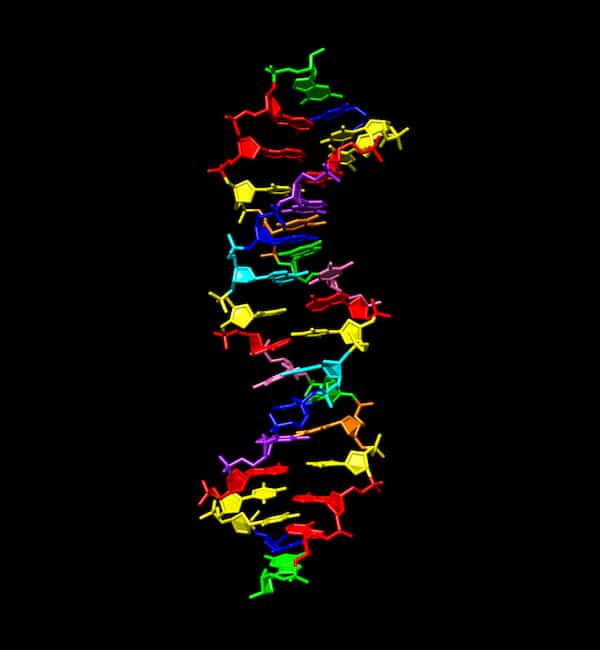Hachioji DNA doubles the genetic code
22 Feb 2019 Belle Dumé
Researchers in the US have built an “alien” DNA system from eight building block letters, so expanding the genetic code from four and doubling its information density. The new system meets all of the requirements for Darwinian evolution and can also be transcribed to RNA. It will be important for future synthetic biology applications and expands the scope of molecular structures that might be capable of supporting life, both here on Earth and more widely in the universe.
One of the main characteristics of life is that it can store and pass on genetic information. In modern-day organisms, this is done by DNA using just four building blocks: guanine, cytosine, adenine, and thymine (G, A, C and T). Paris of DNA strands forms a double helix with A bonding to T and C bonding with G.
Four more building blocks
The researchers, led by Steven Benner of Firebird Biomolecular Sciences LLC and the Foundation for Applied Molecular Evolution, both in Alachua, Florida, have now used organic chemistry to design and make four more such building blocks that fit the size and shape of the G:C and A:T pairs and bind with them. These building blocks are P and B, which are analogs of purine, and Z and S, which are analogs of pyrimidine. These duplexes form P:Z and B:S pairs.
“We made several hundred molecules of this new synthetic genetic system and studied their ability to bind to their complementary genetic molecules,” explains Benner. “This led to rules that predict how well a sequence of synthetic building blocks, say GACTZPSB, bind to a complementary CTGAPZBS sequence.”
The researchers called their eight-letter synthetic genetic system “Hachioji” DNA (“Hachi” means eight in Japanese and “Moji” letter).
Like natural DNA, Hachioji DNA supports life in that it pairs in a predictable way and copies to make a Hachioji RNA. RNA is important for life since it is via this molecule that DNA transfers information before it is sent to proteins.Hachioji DNA also supports life
Benner and colleagues say that the new DNA also, importantly, meets the “Schrödinger requirement” for a Darwinian system of molecular evolution – an important hallmark for supporting life. “Erwin Schrödinger is best known for having created quantum chemistry, but later in his life, like many physicists, he became interested in evolution,” explains Benner. “He noted that to store information, a genetic material must have different building blocks, just like an alphabet must have different letters.”
From a physics perspective, however, these building blocks must be able to replace each other without geometrically disrupting the size or shape of the double helix to support evolution. “Our extra nucleotide ‘letters’ are designed in this way.
Gold
Engineering enzymes to transcribe DNA into RNA
To transcribe hachimoji DNA into RNA, the researchers adapted a natural enzyme (T7 polymerase) so that it could accept unnatural genetic molecules. This is one the main challenges when working with such synthetic DNA systems, says Benner. “Our colleague Andrew Ellington and his team at the University of Texas at Austin re-designed the T7 polymerase, which transcribes natural DNA to natural RNA, by changing amino acids in the protein and finding ones that accept hachimoji DNA to make hachimoji RNA.”
The work tells us much about what chemistry is required to support genetics, he tells Physics World. It suggests that DNA-based life forms other than those that we know on Earth may exist in the Universe. This might be important for when it comes to searching for exobiological “signatures”, he says.
It is wrong to say that hachimoji DNA is alien life though, he insists. For that, the system must also be self-sustaining and Hachioji DNA needs a steady supply of the lab-created building blocks and proteins. “As none of these are available outside, Hachioji DNA can go nowhere if it escapes the laboratory.”
Many potential applications
The potential applications are many, according to the team. “Hachioji DNA could be used to develop clean diagnostics for human diseases, in retrievable molecular information storage, barcoding, self-assembling nanostructures, and to make proteins with extra amino acids as well as novel drugs. Parts of this DNA are already being commercially produced by Firebird.
The researchers, reporting their work in Science 10.1126/science.aat0971, say they are now busy working on engineering bacteria that accept synthetic genetic systems.
physicsworld.com 22/2/2019

Δεν υπάρχουν σχόλια:
Δημοσίευση σχολίου